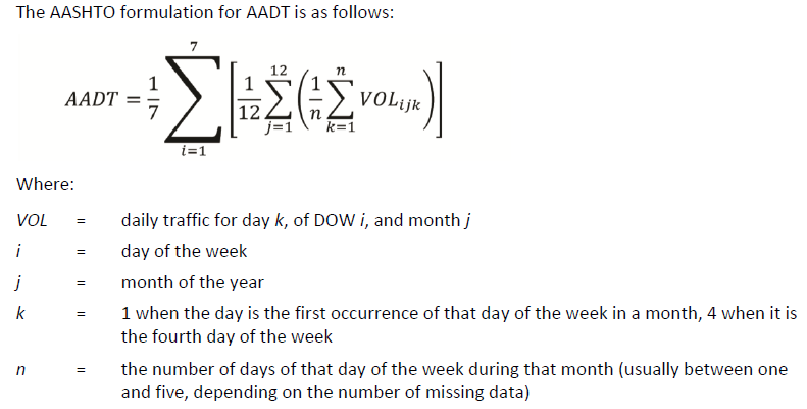About the AADT Metrics
- Overview
- The ASHTO Method for Computing AADT
- The FHWA-PL-16-008 Method for Computing AADT
- The FHWA-PL-16-008 Method for Computing AAWDT
- The FHWA-PL-16-008 Method for Computing AAWET
Overview
The following methods are taken from the 2016 Traffic Monitoring Guide (TMG 2016).
Definitions:
- Annual Average Daily Traffic (AADT)
- Annual Average Daily Non-motorized Traffic (AADNT)
- Annual Average Daily Bicycle Traffic (AADBT)
- Annual Average Daily Pedestrian Traffic (AADPT)
- Annual Average Weekday (Monday through Friday) Traffic (AAWDT)
- Annual Average Weekend (Saturday and Sunday) Traffic (AAWET)
- The AASHTO method to compute AADT only
- FHWA-PL-16-008 method to compute AADT, AAWDT, and AAWET
The ASHTO Method for Computing AADT
We use the AASHTO method listed below. This is the average of averages approach, averaging the 84 average daily traffic values of day-of-week for the 12 months of each year. The AASHTO method is described in the TMG 2016 guide page 1-6.

NOTE:
- We include holidays in our calculation.
- We exclude blank data.
- We exclude data flagged as suspicious.
- We exclude hours if they are missing data for any 15-minute period (for data in 15-minute bins, This does not apply to data with hourly bins)
- We exclude days with less than 23 hours of data (we include days with 23 hrs because of day light saving time)
- If a year is missing at least an entire month worth of data.
- If a month is missing data for any of the week days. For example, if a month is missing data for all the Mondays in the month, we don't compute the AADT. If we have at least one day for all the week days in question in every month, we can compute the AADT.
The FHWA-PL-16-008 Method for Computing AADT
The FHWA-PL-16-008 method listed below is considered to be the better method of computing AADT as opposed to the AASHTO method. The better method (Battelle Memorial Institute for FHWA, Assessing Roadway Traffic Count Duration and Frequency Impacts on Annual Average Daily Traffic Estimation (Krile,et. al. 2015), FHWA-PL-16-008) is described in the TMG 2016 guide page 1-7.

NOTE:
- We include holidays in our calculation.
- We exclude blank data.
- We exclude data flagged as suspicious.
- We exclude hours if they are missing data for any 15-minute period (for data in 15-minute bins, This does not apply to data with hourly bins)
- If a year is missing at least an entire month worth of data.
- If a month is missing data for any of the week days. For example, if a month is missing data for all the Mondays in the month, we don't compute the AADT. If we have at least one day for all the week days in question in every month, we can compute the AADT.
- If we do not have more than 22 hours of data of each day of the week for each month.
The FHWA-PL-16-008 Method for Computing AAWDT
This is the same as the FHWA-PL-16-008 method for computing AADT, but we consider only weekdays (Monday through Friday) and we adjust the equations accordingly.
The FHWA-PL-16-008 Method for Computing AAWET
This is the same as the FHWA-PL-16-008 method for computing AADT, but we consider only weekends (Saturday and Sunday) and we adjust the equations accordingly.